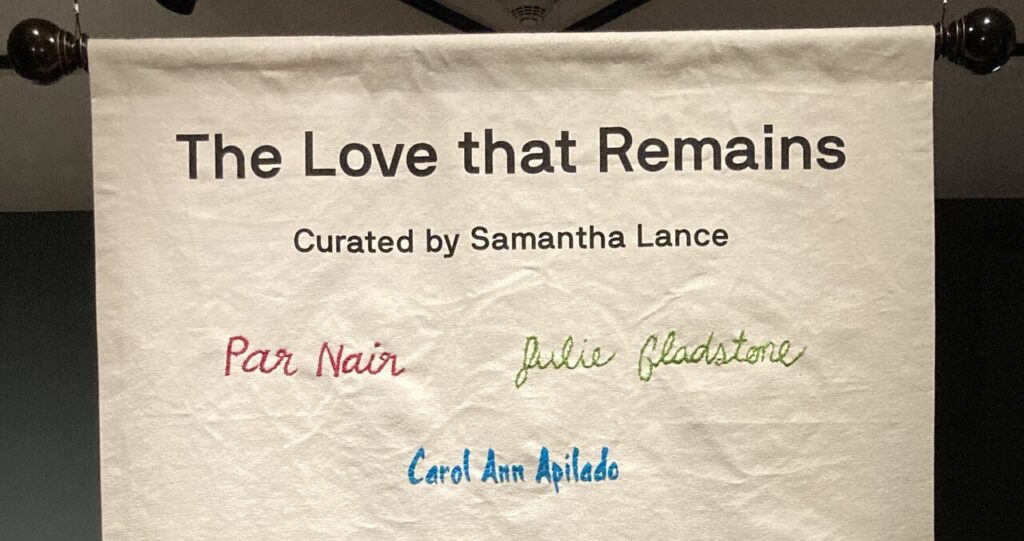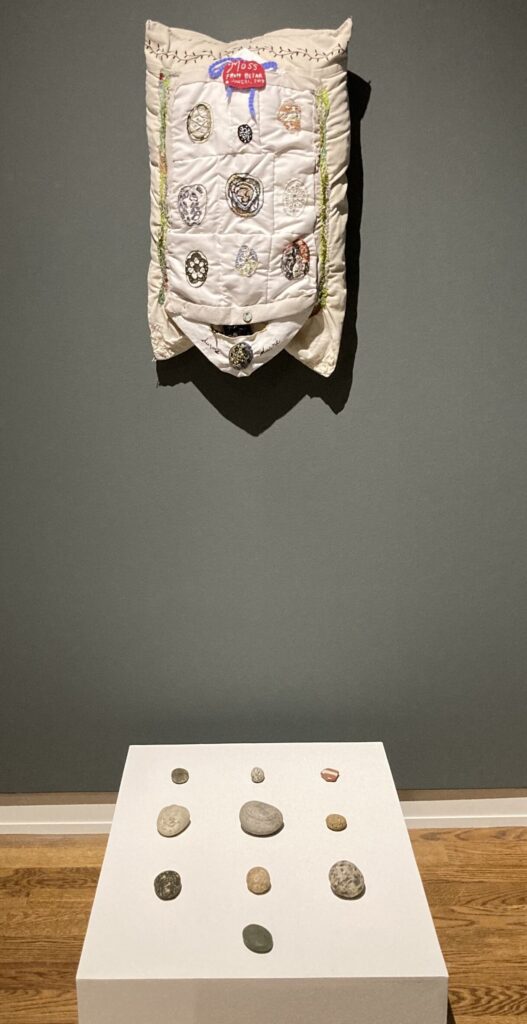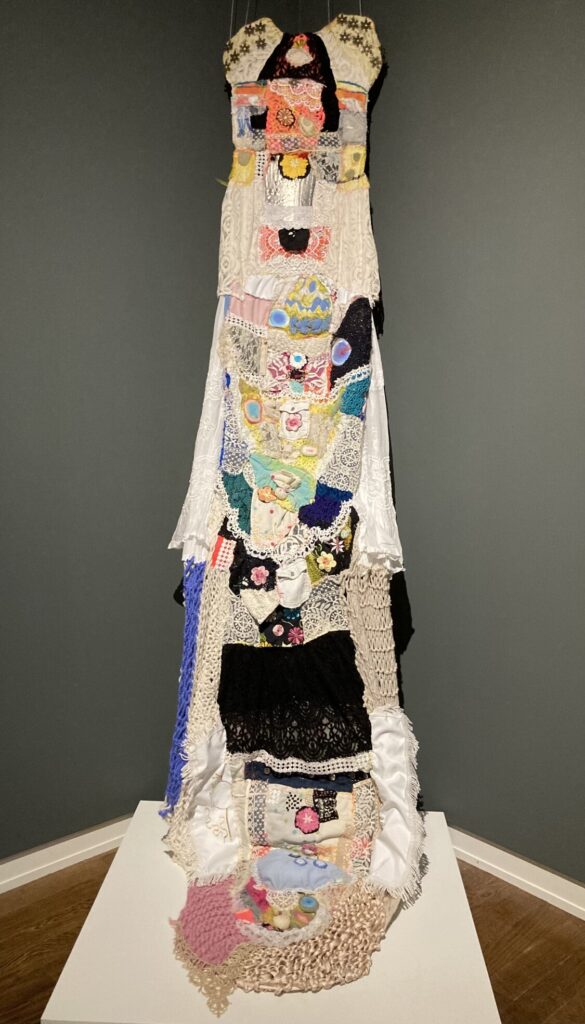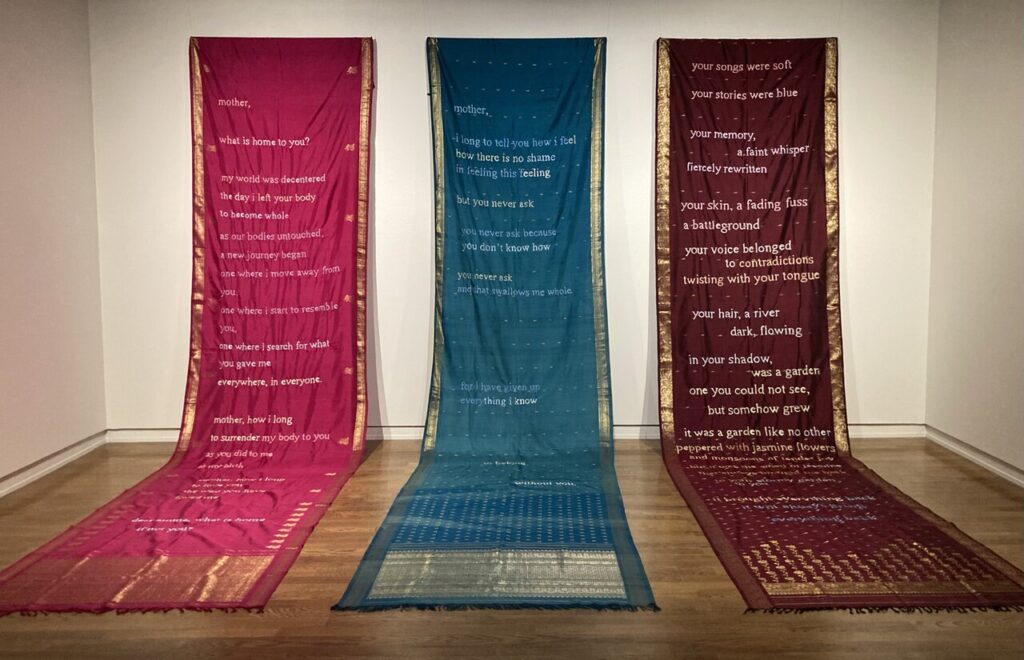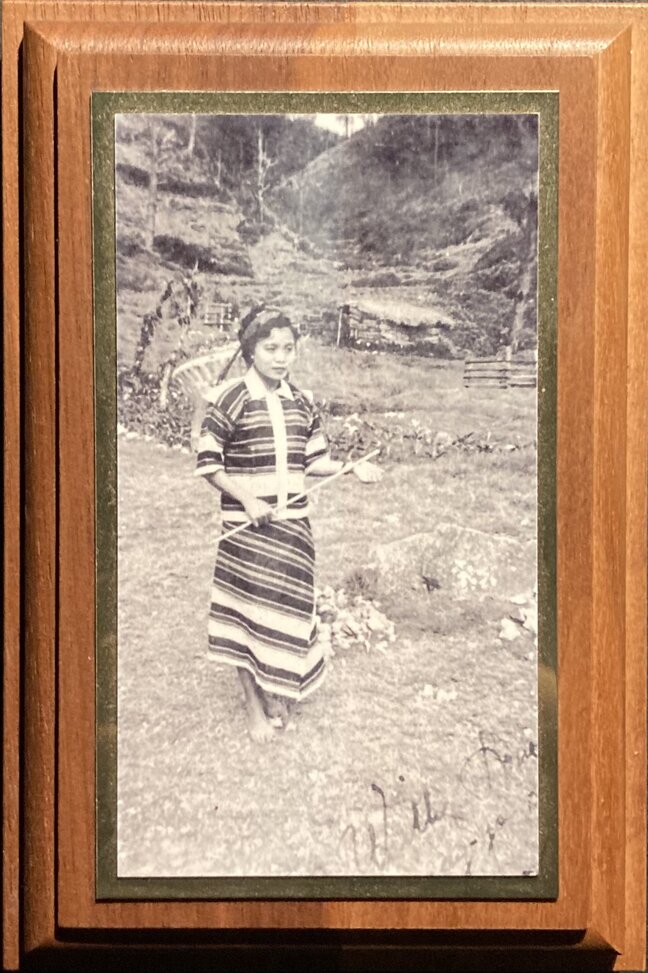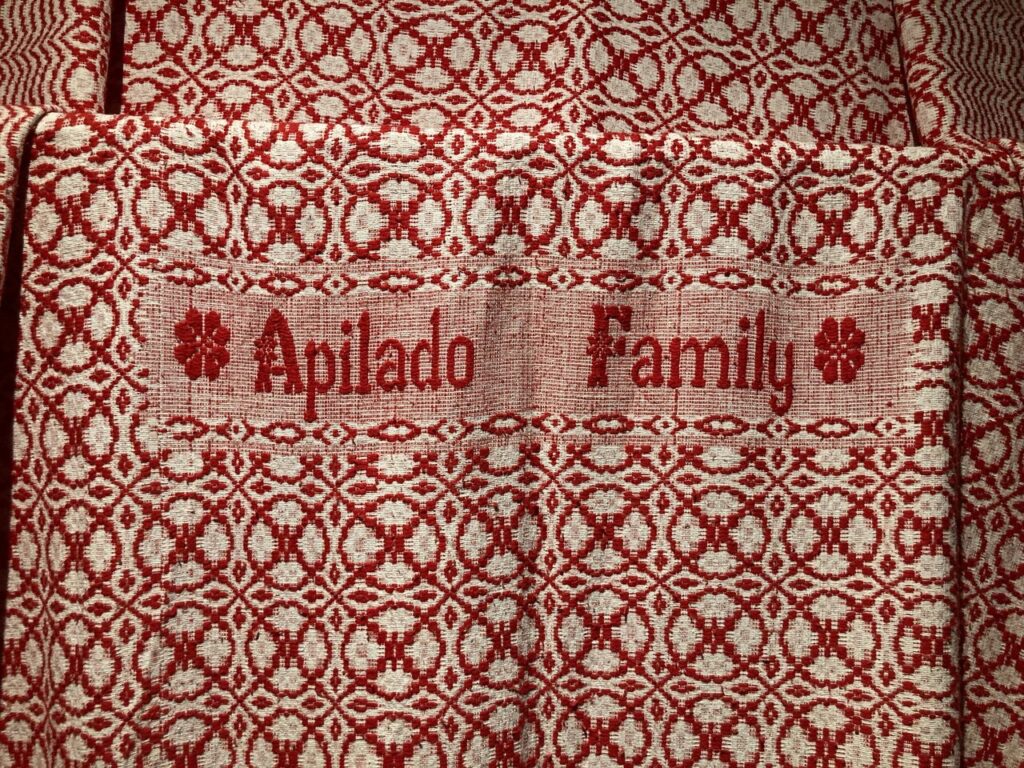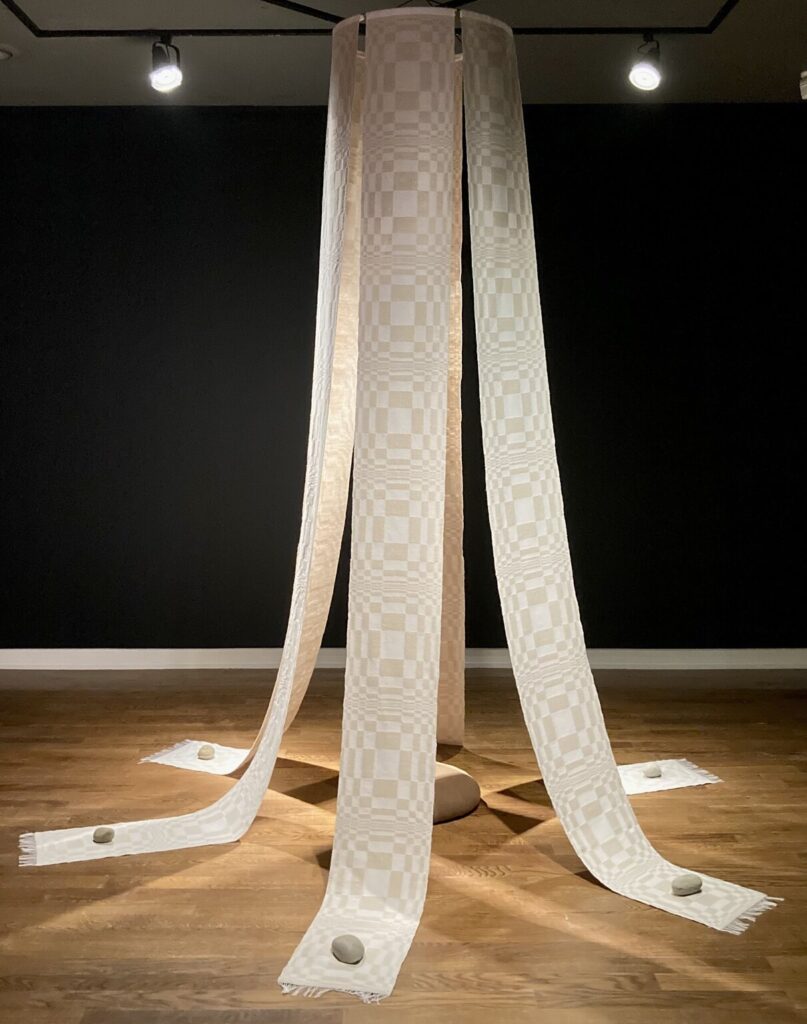In the summer many art exhibitions and programs are offered around the city. I felt the pull to visit The Love that Remains at the Art Museum, University of Toronto. There is something sentimental about summer as a season, whether it is the invigorating sunshine, the memories of vacations from youth, or simply the promise that summer holds. It is a popular time to gallery hop and escape from sweltering hot days. The Love that Remains offers all of this, in addition to a chance to reflect on love, legacies, and longing.
The first piece I saw was a suspended tapestry, with the artists’ names stitched onto the surface. This sentiment of weaving yourself into the fabric of your culture and history is maintained throughout the exhibition. Each of the Toronto-based artists, Par Nair, Julie Gladstone, and Carol Ann Apilado pick up the thread within their families and address the metaphorical knots of hardship that they have to unknot while continuing to experience their intergenerational inheritance.
Exhibition view detail of The Love that Remains at Art Museum, University of Toronto.
People living in a diaspora always struggle to connect with their original culture and identity. Those who immigrate at a young age, find it difficult to remember their homeland or cultural heritage. However, the artists in this exhibition demonstrate their connection to their original culture and their ancestors. These textiles are testament to the care and labour involved in learning ancestral histories and connecting with previous generations. Textiles have historically been understood as the labour of women, one that is demanding but still undervalued. But textiles are valuable for the information they hold: the material sourced from various sites of production, technical skills passed down in regions, arrays of meaningful purpose (for ritual, for protection, to cloth, to house), they embody histories.
Though death separates us from previous generations and cultures, we can continue to honour their memory and legacy. They can live on. We grieve those who have raised us and those we have never known. Gladstone’s “Nomadic Cemetery” (2019) depicts death and remembrance in the form of a transportable tombstone. The work consists of a pillow enclosed in a case, adorned with pockets and embroidered with imagery related to the Kabbalah’s Tree of Life, embodying the idea of how we are connected to each other.
Julie Gladstone, Nomadic Cemetery, 2019. Embroidered lake stones on repurposed pillow and pillowcase, satchel with dirt from former Jewish cemetery in Béjar, Spain and Moss amulet from the Moss man parade. Tree of life altar with lake stones and cemetery offering, 28″ x 16″.
Gladstone’s depiction reflects on the ten spheres representing spiritual principles, in addition to the inclusion of fine leaves framing the pockets in a border and a text noting ‘MOSS FROM BEJAR: JUNE 21, 2019’. Inside the pillowcase is an amulet and dirt from the site of a former Jewish cemetery in Béjar, Spain. Below the case is a plinth with ten stones collected from Lake Ontario, in the same formation as the stitched spheres. The display follows the tradition of leaving stones on a grave to show respect and indicate that they have been visited and remembered. Further, in the symmetry between the cloth component and the stones, there is a pattern of sites connecting Béjar, in which Gladstone’s displaced Sephardic ancestors lived, and Toronto, where Gladstone is currently based.
The desire of connecting across generations, sites, and times is also evident in Gladstone’s “Portal into Dreamspace” (2022). Rather than a tactile textile, the artist has created a digital work of pulsating lace mandalas, echoing the Sephirot sphere of the Kabbalah. The embroidery was designed by Gladstone’s ancestor and has been reinvigorated in this hypnotizing display.
Julie Gladstone, Portal into Dreamspace, 2022. Digital video and soundscape, 03:02.
Gladstone’s “Ancestral Dress” (2023) continues the idea of fluidity in time by reusing remnants of the past to create something new. The draped form cascades towards a low plinth, an assemblage of patterns, textures, techniques, and colours. While some components are identifiable (stitched flowers, lace, pockets, bedazzled arrangements), the dress appears as a shifting, ever-growing form. It is as if another gradient circle might manifest or another row of stitches might materialize. As an homage to ancestors, it makes sense to depict the figure in motion, making it seemingly alive, as the generations will continue. Gladstone’s sculptural work utilizes the items of home (pillowcases, clothing, kitchen textiles etc.), amplifying the familiarity that comes with domestic spaces.
Julie Gladstone, Ancestral Dress, 2023, repurposed clothing, textiles and lace remnants, lake stones, sugar, salt, dried rue, knit wool, and found metal scraps, 105″ x 24″
The repurposing of family textiles forms the base of Nair’s “Letters of Haunting” (2022-23) series. Each work contains a poem stitched onto Kancheepuram silk sarees, wore by the artist’s mother and ancestors. There is always a generational gap that may affect how communication is carried out. Nair also contemplates memory, considering the power of remembering making us ask how many times an ancestor considered the same thought wandering in our minds right now? Experienced the same joy of jasmine flowers? Grieved a similar loss?
Par Nair, Letters of Haunting, 2022- 23, hand embroidery on mother’s silk saree, 210″ x 45″
Inheritance is a theme further emphasized in Apilado’s work reconciling with her Filipino heritage. Along the wall in the third gallery there is a monochrome portrait of a woman standing before a mountainous landscape. The subject is Lola Susana, the inspiration for Ilokano artist Apilado, to rekindle the art of loom-weaving. Apilado’s inclusion of the portrait marks a shift in how ancestors are remembered. Photos, names, and memories are lost between moves and generations. Family members are relegated to distant ancestors without names or faces or forgotten entirely. However, Lola Susana and her family of Ilocos weavers are remembered.
Lola Susana’s portrait, c. 1954–56, photographer unknown, 4″ x 6″
Apilado also included their Family Heirloom Blanket, a woven marker of the Apilado family and their weaving practices. Though the portrait of Apilado’s “Lola Susana” and the “Family Heirloom Blanket” were not created by the artist, both works are meaningful in her art.
Carol Ann Apilado, Family Heirloom Blanket, 1980s to early 1990s. Handwoven cotton or polyester, 68″ x 96″.
A dizzyingly patterned drape installation hangs from a hoop suspended at the ceiling, creating Apilado’s “Channel”. Each panel swoops downwards and is held on the ground by a stone, placed before the fringe. At the centre of the installation is a cushion, a simple place to hide as sounds from a speaker fill the space. The inabel textiles are woven in a binakul pattern. It successfully creates the illusion of movement. The artist’s intent is to create a piece that will ward off evil spirits. Apilado refers to the woven pattern as the kusikus (Ilokano word for “whirlpool”), in recognizing the wind spirit. There is a multiplicity in this work: the woven pattern represents waves of the sea, paired with the sound of waves from the speaker. “Channel” is the embodiment of the channels of waters, channels for frequencies of sound, channelling of spirits. This plurality is intricate and challenging as the artist prompts us to seat beneath the canopy: to meditate and reflect.
Carol Ann Apilado, Channel, 2023, cotton and cottolin (cotton/linen), stones, pillow, approximately 4’ diameter, 12′ high.
When dealing with cultural isolation, distance from your loved ones, and desires to remember your home, what could be better than cloaking yourself in a material version of that love? The Love that Remains is depicting the process of reconnecting with those who have lived before us in addition to those who will come after us. It is the passing of heirlooms, memories, language, and love. Lance’s curation is a thoughtful remembrance of peoples and their labours manifested in textiles. It also ensures that generations have the opportunity to connect with and through their ‘cultural fabric’.
Text and photo: Rashana Youtzy
*Exhibition information: The Love that Remains / featuring artists Par Nair, Julie Gladstone, and Carol Ann Apilado, May 1, 2024 – July 27, 2024, Art Museum at the University of Toronto, University of Toronto Art Centre, 15 King’s College Circle Toronto. Museum hours: Tue, Thu, Fri, Sat: 12 – 5 pm, Wed: 12 – 8 pm.

